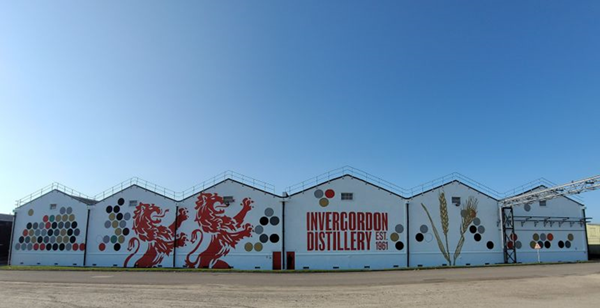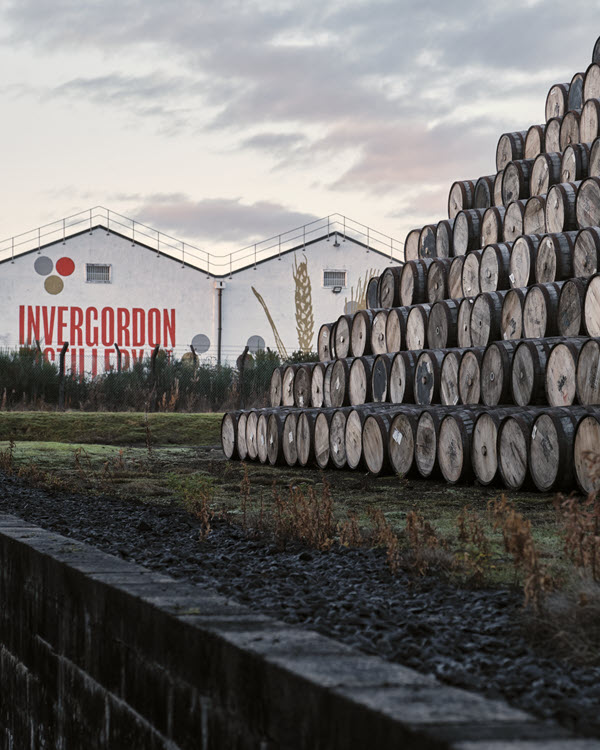Behind the Label: Invergordon
The Scotch industry has barely dabbled in well-aged, premium single grain whisky apart from limited releases and the odd independent bottling. Invergordon is one of the few to have tried, and as it gears up for a second attempt Tom Bruce-Gardyne assesses its chances…
Thirty-three years ago this summer a new Scotch whisky rolled into town. The London Underground was plastered with posters, and there were full-page adverts in ‘The Times’. ‘Abandon your conventional spirit’, readers were told. ‘Experience the Invergordon, a new style of whisky, smooth, fresh, light. Perfect on ice and pure in spirit.’
Invergordon 10 year-old single grain, from the eponymous Highland grain distillery founded in 1961 to help bring employment to the town, was short-lived. There was nothing wrong with its quality, it just failed to cut through the buzz around single malts, and its then owners seemed to lack the resolve to seed the brand for the long-term.
But these weren’t the main reasons. As Ian Palmer, currently MD of Inchdairnie and previously Invergordon’s production manager, explains: “Creating a whole new category is like pushing a snowball uphill, and I don’t think anyone knew what the hell grain whisky was, unless you were in Fife and were drinking Cameron Brig.” This being a brand from Diageo’s massive Cameronbridge grain distillery that was popular in local working men’s clubs.

Invergordon single grain is about to relaunch, and the omens appear much better this time. Brand-owner Whyte & Mackay is planning no Tube campaign or ads in The Times, for this will be a US exclusive with listings in hundreds of Total Wine stores from this autumn.
For Gregor Mina, the firm’s recently appointed innovation head: “It’s a serious attempt to launch a distinctive, premium brand for the long-term with scale.”
The range will include a 14-, 18- and 21-year-old, chosen “because we thought they gave the best example of Invergordon’s signature flavour profile, but they were different enough to warrant exploration,” he says.
“I think we’ve got a range of whiskies that are very accessible in flavour for someone who’s new to Scotch, but they’re interesting and complex enough to attract single malt drinkers. For us they bridge both worlds, particularly in the US where, because of the mashbills and production methods, these are very familiar flavours for American consumers.”
Previous attempts with single grain whiskies have tended to be limited release high-end expressions like William Grant’s Girvan patent still series. The one big exception is the Diageo-David Beckham double-act known as Haig Club, not that most of its consumers know or care that it’s a grain whisky, you would imagine.
Whether you play the category or the brand is an interesting dilemma for producers. Grant’s took a totally branded approach with Monkey Shoulder, guessing that no-one would go into a bar asking for a blended malt. It was no overnight success, but Monkey Shoulder eventually came good thanks to the perseverance of its brand team.
Whyte & Mackay’s new venture is different. “In many ways Invergordon is almost the anti-brand – it’s almost all about the liquid,” says Gregor, though of course there is plenty of branding involved, at least in the packaging which he describes as ‘retro’.

Focussing on when Invergordon was established helps set the brand apart in his view. With Scotch being “very much rooted in the past with our heritage which gives us a lot of credibility, this is about the sixties,” he says.
“From a liquid perspective, there is such an interesting intersection between price and age,” he continues. “All of them are going to be under US$200 including the 21 year-old, and you wouldn’t be able to do that with single malts because of the stocks. It really opens up to an entirely new set of consumers who would love to try older expressions, but maybe find the price point [with malts] a barrier to entry.”
Getting the price right will clearly be crucial to Invergordon’s success. You need to aim high, especially in America where the top-end is driving growth in almost all drinks. Yet within Scotch, not too high given the US conviction that malts are best.
“I think there’s definitely a stigma attached to grains and blends with some consumers, though they tend to be older,” says Gregor who is pinning his hopes on a younger, more open-minded demographic.
America is a tough nut to crack being so expensive and competitive, but it is the number one premium spirits market in the world. “From our perspective, it felt somewhere that would be a great place for us to show proof of concept,” he says. “But more than that, it’s just a great place to start and grow the brand, and there’s a lot of head-room.”
Invergordon won’t really shift the dial on single grain exports to the States, which equated to a mere 80,000 bottles in 2022, compared to 27 million for single malts. It will take many more brands to lift it from a tiny niche. But once upon a time an unknown brand called Glenfiddich faced the same issue when there was nothing but blended Scotch.
So, it can be done. You just need the right timing, the right pricing, great quality, a lot of luck and serious, long-term resolve to build the brand. “At Whyte & Mackay we have an expression – ‘you have to launch and love’,” says Gregor. “Without ‘love’ over the years, it’s not going to work.”

Award-winning drinks columnist and author Tom Bruce-Gardyne began his career in the wine trade, managing exports for a major Sicilian producer. Now freelance for 20 years, Tom has been a weekly columnist for The Herald and his books include The Scotch Whisky Book and most recently Scotch Whisky Treasures.
You can read more comment and analysis on the Scotch whisky industry by clicking on Whisky News.




